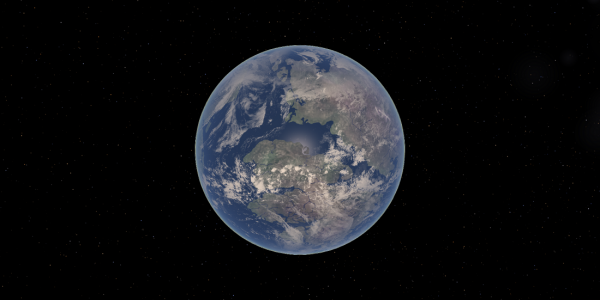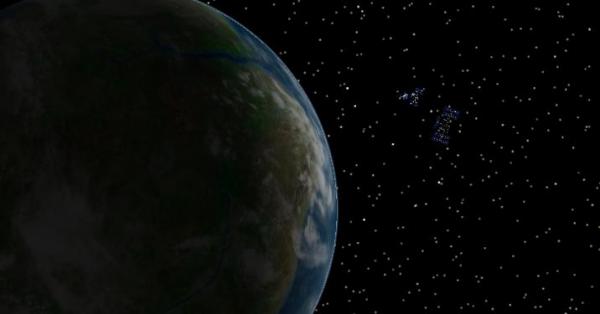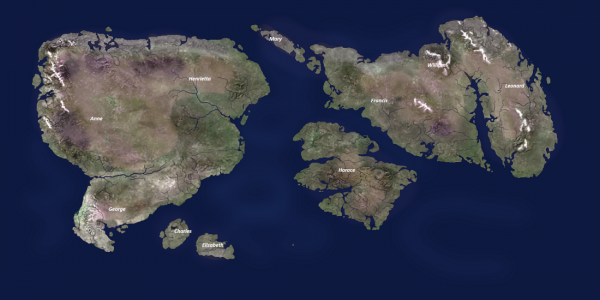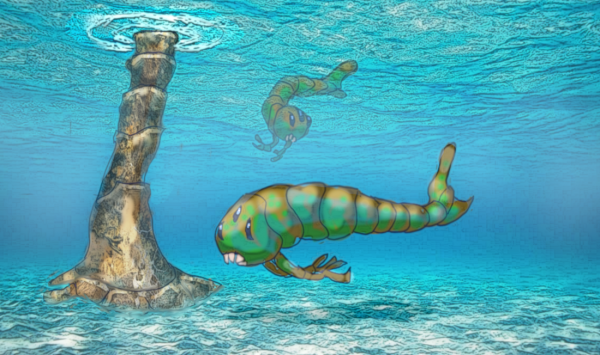BY LETTER
Darwin (Life-bearing World)
Galactography > Sephirotic Empires > Caretaker Gods
Galactography > Regions of Space > Inner Sphere
Galactography > Systems and Worlds > Systems & Worlds C - D
Galactography > Regions of Space > Inner Sphere
Galactography > Systems and Worlds > Systems & Worlds C - D
Darwin, in the Delta Pavonis system | |
 Image from The Astronomer | |
| Darwin is one of the closest life-bearing worlds to Sol | |
Darwin (Garden World) | |
| Star | Aristotle, Delta Pavonis (see separate article) |
|---|---|
| Orbital characteristics | - Semi-major axis: 171,738,000 km (1.148 AU) - Period: 451.3 days (1.236 Julian years) - Eccentricity: 0.005 |
| Physical characteristics | - Type: PostGaian life-bearing world - Mass: 1.205E+25 kg - Radius: 7,942.9 km - Density: 5,741 kg/m^3 - Gravitational acceleration: 12.747 m/s^2 (1.299 g) - Rotation period: 108,515 s (30.143 hr) - Obliquity: 22.1° - Albedo: 0.339 - Average surface temperature: 295 K |
| Atmosphere | - Surface pressure: 122.7 kPa - Composition: 83.0% N2, 16.4% O2, 0.5% Ar, 0.1% CO2, traces of other gases |
| Satellites | 1) Wedgwood: Type = Selenian. Radius 1672.2km Orbital Period 30.4 standard days |
| Colonised | 691 AT |
| Allegiance: | Caretaker God (Darwin ISO) |
Neumann Probes
In the early days of space exploration, star-system after star-system turned out to be devoid of life. There were some during this time who speculated that Earth was the only place in the entire universe that was home to life, and that the true purpose of mankind was to seed a barren universe with life.In the Interplanetary Age the discovery of biosignatures on an inner planet of the sun-like (yellow dwarf) G8 star Delta Pavonis changed all that. A standing ocean of liquid water was also detected. Especially following the disappointment of the Europan oceans being barren of life, this apparent discovery of a natural biosphere caused great excitement. The exploration of Delta Pavonis was made an international scientific priority. Getting funding for the mission however was another matter.
At this time space exploration was dependent on the big interplanetary corporations, resources were limited (the construction of a particle launch stream was an extremely expensive project), and most of the available funds were going into the exploration of the nearby stars Alpha Centauri and Tau Ceti. At almost 20 light years, Delta Pavonis was over four times as far as the former, and nearly twice as far as the latter. An unmanned probe would take almost two centuries to arrive.
Nevertheless, with pressure from scientific institutes throughout the solar system, and some clever advertising, mission enthusiasts got a lot of popularity, and in 291 a neumann probe propelled by pellet-stream/magsail, the Carl Sagan, was launched towards Delta Pavonis. More advanced then earlier probes like the Giordano Bruno that was sent to Tau Ceti, the Carl Sagan would reach a velocity of more than 0.1c.
In 483 a transmission from the Carl Sagan reported back to Earth. Delta Pavonis was indeed a rich system (scientists had long expected this, as the star's metallicity was almost twice that of Sol's) and in addition to the fourth planet which indeed had an alien biosphere consisting of microbes and a few small mesoscale organisms, there were a number of other rocky planets and gas giants. Darwin also proved to have a rich fossil record, showing that the planet had once held much larger organisms which were now extinct.
Authorities agreed that the fourth planet, which they named Darwin, would become a scientific preserve. The rest of the system could be industrialised. The distance still made it hard to stir up enthusiasm in the mission, although the various Sol System corporations were not slow to carve up a piece of the pie. The various interested parties formed an alliance known as the New Life Consortium, and further neumann probes were sent to prepare the way.
 Image from Steve Bowers | |
| Darwin | |
The Early Colony
Problems of private nanotech and increasing anxiety over social disruptions meant the authorities had other things on their mind, and it was not until 491 AT that the New Life Consortium launched the manned colony ship Evolution. This ship carried a crew of tweaked humans, tolerant of deep space conditions and with enhanced longevity, not unlike the Nova Terra and Penglai missions. The timing was unfortunate, because by the time the colonists arrived in 691 AT the Sol System back home had been laid waste by the Technocalypse and the Great Expulsion.During the following centuries the colonists struggled to establish a home in orbiting habitats, the asteroids, and even commenced the terraformation of the Mars-like world Mendel. They developed a pure scientific community, dedicated to a new civilization without commercial exploitation. The situation was complicated by the arrival of several GAIA arkships (mostly carrying refugees from Earth and the Belt) but the newcomers and the original scientist settlers worked together, and by the 9th and 10th centuries several demopolies were in existence. At this time the star was given the name Aristotle, to honour this early naturalist and philosopher.
 Image from Steve Bowers | |
| The land masses on this world are named after the children of Charles Darwin, who gave this world its name. In the Current Era this planet has very few permanent inhabitants, most of whom are engaged in monitoring the environment of this world. | |
The Federation Megacorps
The arrival of the Federation of Sophonts in the 11th and early 12th centuries seemed at first to usher in a new age of prosperity and learning. The Federation had a high regard of knowledge for its own sake, and whilst the biosphere on Darwin was a mere remnant of its original glory, the organisms that remain hold enough information to permit relatively realistic reconstructions to be produced by genetic engineers.Federation technology and industry began developing the rest of the system. But by the 13th century, Federation corporations and private investors were looking to the alien biosphere of Darwin as a source of useful and novel genetic material.
Following Birnam Ecotech's illegal theft of samples from the surface, the Aristotle administration slapped an embargo and system-wide ban on all federation biotech companies.
In response, the biotech corporations began using their media clout to slander the Aristotleans as xenophobic, ludditic, and anti-Federation, taking snippets of interviews and educational interactives out of context to paint them as a hostile and ignorant horde. The problem was confounded by the fact that there were some locals who supported the megacorps, had profited from the increased standard of living the corps brought, and some even wanted to settle the surface of Darwin.
The scientists meanwhile initiated their own memetic warfare, broadcasting over the AristotleNet and beaming back to Sol that the corps were incompetent, and if they were not controlled they would "do to the rest of the universe what their predecessors had done to Earth" Images of Corporation development plans, and lurid immersive projections of waste dumps despoiling the pristine environment of Darwin were they to be allowed to go ahead, seeming completely ridiculous, until the Nova Terra mediacorps got in on the act. Novamedia of course did not give a damn about scientific value, pristine wilderness, or preserving diversity. All they were concerned about was a good story, and with the increasing breakdown of the old federation society, people were looking for scapegoats. Greedy megacorps, constantly being painted as oppressive overlords who had replaced the original Federation social equality (in fact there never was any such thing!) with a monopolistic market economy that squeezed out smaller competitors (this in fact was happening in some places), made a perfect target and the ratings of the big novamediacorps soared.
As various telenet media interests took up the cause, and the Florists and their supporters began fighting back with their own propaganda, venture capitalists in the Nova Terra orbitals and the Tau Ceti belt began setting up small media corps; including the pro-scientist Nova Watch, and the pro-colonists New World.
Although a majority of orbitals and moon and asteroid habitats were on the Aristotle administration side, the pro-bio-development and pro-surface colonization habitats increasingly sided with the development and biotech corporations. Meanwhile some in-system baselines, space adapts, and cislunar superiors began taking steps towards aligning with them and setting up an alternative government in opposition to the Aristotle Administration. The problem was that neither side could agree on fine points, and the result was a number of warring clades, funded and encouraged by various off-system corporate, developmental, and media interests.
When several settler factions decided to set up habitats on the surface of Darwin, the planet become an ecological battlefield, as a number of Aristotleans, inspired by lurid (and increasingly exaggerated) images of ecological vandalism, adopted radical Gaianist policies. Seeing the destruction wrought on Earth and not wanting to see this new wilderness spoilt any further, they began reverting to terrorism, and in 1341 the planet-side settlers responded, so that each side was raiding and sabotaging the other. When it seemed like an actual shooting war would developed between the two faction, the Aristotle administration decided to send in paramilitary peace-keepers, who instead as being welcomed as saviors found themselves reviled from both sides.
The Battle for Darwin
Most of the Battle for Darwin was waged off-planet. The arrival of the Federation turned out to be good news for the eco-activists and their media allies. Already having developed memetics to a fine art, and demonised the Florist colonists as vandals comparable to the worst of the industrial and information age, they broadcast their messages back to the Sol System. Gaianist and ecological activists back in the Sol System began petitioning the Federation to put pressure on the Darwin squatters. The Darwin Biosphere Protection Act was instituted, and a number of scientists and ecologists arrived from Sol. However, they were no more able to shift the powerful but isolated Darwin colonists (already well armed with their own (banned) Darwin's People Defense Army). This was the first realisation for the Federation that it could not administer interstellar colonies the way it could the Sol system. Both in the Sol System and at Aristotle a number of ecological and Gaianist radicals, with the backing of corporations like GeneLife and Birnam Ecotech that stood to benefit by the closing off of natural Garden Worlds (and hence forcing a greater reliance on their services) formed a number of institutions like Life First! and Guardians of Darwin, that were later to coalesce into the powerful Guardians of Bios League. Even before the formation of the Guardians of Bios, ecoactivist bioborgs had established the Darwin Liberation Army and were waging a guerrilla war against the Darwin colonists that was far more devastating than anything the ecologists or the local Space Guard could do. The Darwin colonists found themselves completely out-classed by bioborgs gengineered for combat and infiltration, while the big Novamediacorps and their local franchises lapped it all up, sending ratings both at home at at Sol going through the roof.Although many independents and pro-industrialist habitats sided with the colonists, sending them weapons and technology and providing them with aerospace support, some of the eco-sympathetic orbitals began giving their support to the DLA bioborgs. Unity and many of the haloists remained neutral. In 1390 the situation escalated into a full-scale shooting war, the Battle for Darwin. Despite being out-numbered and outgunned in terms of gross firepower, the DLA had access to state of the art Federation stealth and nanotechnology, and the Florists and their supporters were defeated with heavy losses.
In 1391 the Provisional Darwin Administration was set up, and the defeated colonists were placed in orbital camps pending a decision as to what would become of them. The war over, the media lost interest, although occasional stories from Darwin colonist exiles were always good for a human tragedy report in the off-ratings period. Simmering problems with exiles (including acts of terrorism) were to continue until they were relocated to Mendel, which was gradually being terraformed,and other worlds in this system. Some were eventually relocated on Little Garcia, a half-terraformed moon in the Epsilon Eridani system, and after the fall of the First Federation, a number of ex-Darwin colonists went on to found a new colony on the twin worlds of Helen and Clytemnestra.
In the Current Era Darwin is a nature reserve, with very few Terragen inhabitants; the largest population in this system is on Mendel, now fully terraformed. Mendel also holds a rich diversity of lazurogened creatures derived from the extinct species that once roamed Darwin.
A population of several billion Terragens inhabit a swarm of largebubblehabs in the gas giants of Wallace and Huxley. Some provolution of the lazurogened Darwin species is occuring on Linnaeus, which is cooled by a Lagrangian sunshade; but no sophont species have been produced yet.
 Image from Steve Bowers | |
| Lazurogened Paraeurypterids swimming in a mangrove coral forest on Mendel. Although they are segmented, paraeurypterids have much in common with primitive Terran fishes as well as with arthropods. | |
Xenobiology
Life on Darwin is currently in a PostGaian stage, mostly consisting of microbes and degenerate forms smaller than a millimetre in length. The planet suffered a final worldwide extinction 400 million years ago, and the biosphere has been a mere remnant since that time. The Delta Pavonis system is somewhat older than Solsys, and the biosphere had existed for several billion years before this last extinction. Apart from the quota of scientific stations, the rest of the land surface is barren.The extinct biosphere on Darwin was fairly simple by Terragen standards, roughly corresponding to the Devonian period of Old Earth. The oceans were filled with seaweeds and small creatures living on them, a rich diversity of soft-bodied invertebrates, including lobopod, proto-gastropod, and annelid analogues as well as phyla with no functional equivalent in terragen life. At the top of the food chain were the Paraeurypterida, armoured predators with a mouth like a pineapple ring, that looked like a cross between sea scorpions and anomalocarids, and attained 2 meters in length.
The most commonly found water animals were the Parvonivalvia, or "polys" shelled filter-feeders that looked like regular polyhedrons. Their shells were commonly found on beaches. A lazurogened version of these creatures are easily bred in aquariums in orbital habitats, where the shells are sold to tourists, or widely used for decorations.
The polys were in turn preyed upon by the handfishes or Parvonacarida, swimming armoured predators with jointed mandibles at the front looking not unlike hands or claws. They were superficially similar to, but actually unrelated to, Paraeurypterida, with the larger forms reaching 50cm to a meter in length. Using the "hand" they crushed polys and ate the contents. A related group, the Monomandibulata, lost their swimming tails and crawled around on the mandibles; the Medelians call them "things" in honour of an ancient pre-singularity media drama. Other species which have been recreated on Mendel include ribbonshrimp and coneys.
Land life consisted of scrubby moss-like plants and shrubs, and carpets of biofilm covered with a resilient glass-like protective layer. Near the shore, aquatic corals extended tree-like polyps into the air and formed mangrove-like forests in the littoral zone. The photosynthetic pigments used included chlorophyll and carotines.
Related Articles
- Aristotle (Delta Pavonis)
- Xenobiologist
- Xenobiont
- Xenobiota - Text by M. Alan Kazlev
The totality of non-terragen life on a specific planet or non-terragen ecosystem.
Appears in Topics
Development Notes
Text by M. Alan Kazlev and Anders Sandberg
updated by The Astronomer and Steve Bowers
Initially published on 14 October 2008.
Revised 4/08/2020
updated by The Astronomer and Steve Bowers
Initially published on 14 October 2008.
Revised 4/08/2020






